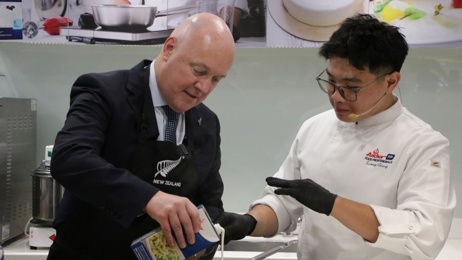
COMMENT:
Contrary to Mathew Hooton's comment (NZ Herald, August 14), whether Jacinda
Ardern or Judith Collins is prime minister next year, neither would allow Covid-19 to gain a hold in New Zealand. They will not be so ill-informed.
What the epidemiological evidence informs us is that within one month of infection with Covid-19, you will either be dead or no longer infectious. The bad news (I'll come to the good news later) is that approximately one out of every 100 people infected will die within a month.
Estimates vary from between one death among every 200 infected people to one out of every 70 infected people and the proportions differ significantly by age. But these differences are largely irrelevant. What is relevant is that Covid-19 is 20 to 40 times worse than seasonal flu and people of all ages have a substantial risk of infection and of infecting others, of all ages.
It might not kill you, but your infection might be the cause your grandmother's death.
There is further bad news. Without any restrictions, it is estimated that one person will infect between two and three other people and the number of cases in any single setting, can double every two days, from 1 case to 2 to 4, 8, 16, 32 etc. About one in every five of these infected people will require hospitalisation and about one in every five of hospitalised people will require intensive care.
The exact numbers again are not important, what is important is that hospital services will be rapidly overwhelmed. We have all read about the rotting Covid-infected corpses spilling out of refrigerated trucks in New York City, one of the wealthiest cities in the world.
And yet some commentators have tried to argue that the Covid crisis is largely hysteria! In addition, there are increasing reports of long-term after-effects of infection.
What Hooton and other commentators (including Kate MacNamara in the same issue of the NZ Herald) tend to do when arguing that "Covid ain't that bad" is to bring up Sweden.
What experienced epidemiologists do is to systematically identify and critique the totality of evidence, something most commentators on the subject simply do not have the skills or experience to do. This systematic and critical approach is particularly necessary when examining evidence about Covid-19 infection because it is hugely influenced by the setting in which the infection occurs.
Think of a person infected by Covid-19 as being like a spark that has jumped out of a fire. If it lands on bare earth, it rapidly dies out, if it lands on a small clump of trees, it may catch fire for a while and then die out, but if it lands in a large tinder-dry forest, it rapidly gets out of control. If you examine any one of these outcomes in isolation from the others, you could come to completely different conclusions.
Using this analogy, the situation in Sweden, so far, is the equivalent of a spark landing in a small clump of trees. About 55 per cent of Swedes live in single person households, the highest proportion worldwide, yet most community spread worldwide occurs in multi-person dwellings.
Recently on social media, a Swede asked when he could go back to his usual 5 metre distancing. He found the recommended 2 metre distancing too uncomfortable. No other country has such a high level of structural and cultural physical distancing.
Despite these huge advantages, and the seldom acknowledged fact that Sweden did introduce a raft of restrictions, including shutting all senior schools and universities, they have experienced one of the highest number of deaths per million population of any country in the world (eighth highest), yet only about 6 per cent of the population have been infected so far.
Rather than Sweden being an example of how benign Covid-19 is, it demonstrates the exact opposite.
Moreover, to continue the spark analogy, one of the most foolhardy plans of policy makers in several countries, including Sweden and the UK (third highest deaths per million), was to let the fires burn until there were insufficient trees remaining to sustain the fire.
We call this phenomenon "herd immunity" in infectious disease epidemiology. It occurs when a sufficient proportion of a population have become immune, as a result of infection or a vaccine, and the virus cannot find enough nonimmune people to keep going.
For Covid-19, it is estimated that about 60 per cent of the population need to be immune to gain herd immunity, yet, despite the havoc already caused by Covid-19, no country has even got to 10 per cent infected. Also, the 60 per cent immune figure is based on the assumption of a controlled increase in immunity, as a result of vaccination.
While a reasonably controlled forest fire might burn out when 60 per cent of the trees are destroyed, an out-of-control fire might destroy 90 per cent of the forest before burning out.
However, whether the number is 60 per cent or 90 per cent is somewhat irrelevant, given that no country is anywhere near either number and we are still waiting for a vaccine.
To add "further fuel to the fire" (apologies for the pun), immunity might not last very long - the trees may be regrowing more rapidly than they are being destroyed and the fire might continue for years.
So, what is the good news? Firstly, Covid-19 only lasts a maximum of a month, by which time you are either dead or no longer infectious. Secondly there is a golden window of four to five days between when you are infected and when you become infectious (it's only about two days for flu).
Taiwan's testing, tracing and isolation strategies reaped success. AP Photo / Chiang Ying-ying
Covid-19's golden window makes it possible for an efficient testing, contact tracing and isolation system to stamp out new outbreaks rapidly by identifying infected people before they infect others, as best illustrated by Taiwan's success.
The one-month lifespan of a Covid-19 infection means that a four- to six-week lockdown can also stamp out the virus, as best illustrated in New Zealand a few months ago.
There is no viable alternative to implementing either one or both these strategies for most countries, unless an effective vaccine is developed or the virus mutates into something less serious.
Which one of these strategies or what mix of both is used depends on how widespread the outbreak is when it is discovered.
If we just let the virus rip, there will be chaos, if we do it half-heartedly, people will continue to die and every time you venture out, you could be infected and bring it home.
It will never be safe to visit anyone over about 65 years of age and you might still cause the death of child, teenager or young adult.
New Zealand experienced more than 100 Covid-free days and there is no reason why we can't do better after we stamp out the current infections. We will learn from this minor setback.
We will need to continue to quarantine everyone at the border, but there is every reason to believe that in time, this will become much more efficient and will enable entry to essential workers, foreign students and tourists willing to quarantine.
Hooton states that "managing the entry of Covid-19 into the population over the next 18 months is the only realistic option" but the evidence suggests the opposite is the only viable option.
He goes on to state that "the data from both successes and failures overseas will be useful in working out how to do this" and suggests that "Sweden offers insights into both" and provides a table of mostly useless data to support his premise. The only data in the table with any meaning are the number of people living in Sweden and the number of Covid deaths.
The 83,000 confirmed cases include only about one in seven of true cases according to large scale antibody studies in Sweden, so it is useless information.
This makes his infection rate and death rate (of cases) calculations worse than useless information.
US President Donald Trump has presented similar calculations. The death rate (in the total population) is only meaningful for international comparisons with countries that report their deaths with similar accuracy, and actually demonstrates Sweden is a failure rather than a success.
Hooton tries to argue that Covid-19 represents almost no risk to people up to age 60 years because the death rates in the total population are so low, but he misses the point that only 6 per cent of Swedes have been infected so far.
For the data from both successes and failures overseas to be useful in working out what we should do in New Zealand, commentators need to understand the data.
As far as I am aware, every experienced New Zealand epidemiologist supports our current elimination strategy and we have provided this advice to government.
- Rod Jackson is Professor of Epidemiology at the School of Population Health Faculty of Medical and Health Sciences, University of Auckland.
Take your Radio, Podcasts and Music with you









